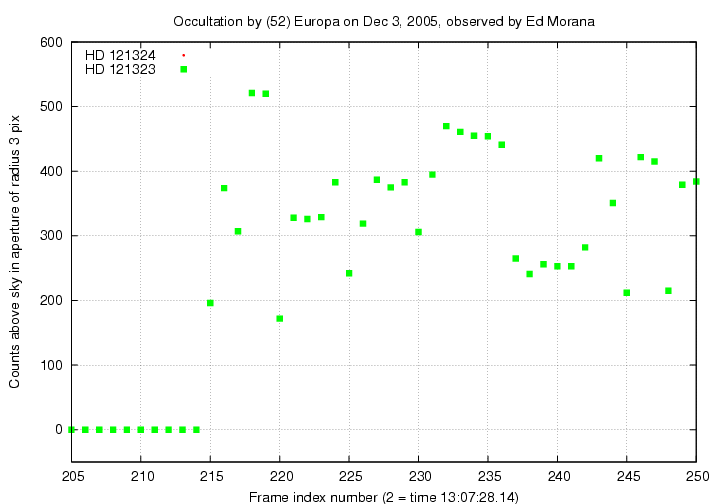
 Copyright © Michael Richmond.
This work is licensed under a Creative Commons License.
Copyright © Michael Richmond.
This work is licensed under a Creative Commons License.
On Dec 3, 2005, Ed Morana watched the asteroid (52) Europa cover the star HD 121323, also known as SAO 139619 = TYC 4974-00584-1. His location for observing this event was near San Luis Obispo, California, USA. You can see his report at http://pictures.ed-morana.com/AsteroidOccultations/
His equipment included
Each video frame has a time stamped on it, according to the KIWI OSD protocol. Below is an example, frame number 2 in the sequence. The video file contains frames 320x240 pixels in size, in WMV format.

Note that each frame in the movie file contains a single field of video data (1/60 of a second); only every other field is present in the movie file I was given. That means that the times stamped onto each frame jump discontinuously: frame number 2 runs from 13:07:28.129 to 13:07:28.146, frame 3 from 13:07:28.163 to 13:07:28.179, frame 4 from 13:07:28.196 to 13:07:28.213. In short, half the video fields are unavailable.
I also noticed that the first frame in the movie is duplicated in the second frame.
I processed this movie file in the following manner:
I will skip frame 1, since it duplicates number 2. The times on first good and last frames in my set were
This yields a frame rate of 29.969 frames per second.
There are two stars visible in the field:

The fainter star near the center is the target star, HD 121323, which has Tycho magnitude Vt = 9.01. The brighter star in the lower-right corner is (I think) HD 121324, aka HIP 67949 = SAO 139617. It is brighter in the V-band, with Vt = 7.99, and certainly looks brighter on the video. Neither star is apparently saturated in the FITS images I created from the video: the brighter reference star had peak values around 160 counts, out of a maximum of 255 counts; the target star had peak values around 100 counts. The FWHM of the stellar image was around 2 pixels.
For each of the 297 good frames (ignoring frame 1), I
To gauge the precision of the photometry, I calculated the mean flux and standard deviation from the mean for each star over the first 70 frames.
star mean counts standard deviation
-------------------------------------------------------------------
reference star 1124 226
target star 302 82
--------------------------------------------------------------------
In short, the precision of the photometry is around 20-25 percent.
Here are quick views of the results.
The entire light curve:

A closeup around the disappearance:

A closeup around the reappearance:

You can grab the data in a multi-column ASCII text file below. The columns are
col quantity
------------------------------
1 frame index
5,6 flux of ref star HD 121324 in 2-pixel aperture,
and estimate of uncertainty in that flux
7,8 ditto 3-pixel aperture
9,10 ditto 4-pixel aperture
11,12 flux of target star HD 121323 in 2-pixel aperture,
and estimate of uncertainty in that flux
13,14
15,16
 Copyright © Michael Richmond.
This work is licensed under a Creative Commons License.
Copyright © Michael Richmond.
This work is licensed under a Creative Commons License.